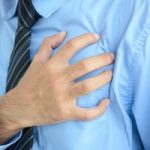 Angina in the elderly is quite a common occurrence. It is characterized by tightness in the chest and chest pain as a result of reduced blood flow to the heart. Angina is not a disease on its own, but rather a symptom of coronary artery disease. Patients may experience tightness, pain, squeezing, pressure, or heaviness of the chest.
Angina in the elderly is quite a common occurrence. It is characterized by tightness in the chest and chest pain as a result of reduced blood flow to the heart. Angina is not a disease on its own, but rather a symptom of coronary artery disease. Patients may experience tightness, pain, squeezing, pressure, or heaviness of the chest.
Angina is sometimes referred to as angina pectoris and can either be a chronic condition or appear suddenly.
Advertisement
The scary part about angina is that although common, any pain that is experienced in the chest could potentially be linked to a life-threatening heart condition, so it should not be ignored.
Angina can be managed, but only if it is diagnosed. If you experience chest pains, you should be tested for angina and also work towards reducing your risk factors that could contribute to heart disease and heart attack.
The below articles will highlight different aspects related to angina including the different types like microvascular angina, prinzmetal angina, unstable angina, stable angina, variant angina, and atypical angina.
Microvascular angina: Symptoms, diagnosis, treatment, and prevention
Indigestion can cause a sense of heaviness or a sharp pain in the chest, but sometimes that twinge can be something more serious, such as microvascular angina. Just what is microvascular angina? Read on and find out what a microvascular angina diagnosis means and how you can treat or prevent it.
Microvascular angina is a concerning source of chest pain because it is commonly misdiagnosed. The reason for this is that unlike some other heart-related issues, it does not show up as a blockage in the large heart arteries during tests. In other words, doctors can miss the underlying cause.
It is worth knowing that this type of chest pain is more common in women than it is in men. Continue reading…
 Can you treat prinzmetal angina at home? Causes, symptoms, and treatment of variant
Can you treat prinzmetal angina at home? Causes, symptoms, and treatment of variant
Coronary artery spasm (Prinzmetal’s angina) is a type of angina that occurs at rest. It’s brought on by a spasm in the coronary artery, causing temporary narrowing of the artery. Although it can be relieved with medications, it is still a very severe condition. On an electrocardiogram, Prinzmetal’s angina—also called variant angina—appears with episodes of ST elevations.
Angina is characterized by tightness in the chest and chest pain because of reduced blood flow to the heart. Angina is not a disease on its own, but rather a symptom of coronary artery disease. Patients may experience tightness, pain, squeezing, pressure, or heaviness in the chest. For some, angina can be sudden, while in others, it can be a chronic condition.
Aside from variant angina, there is also stable angina and unstable angina. Stable angina is triggered by physical or emotional exertion. In unstable angina, plaque in the blood vessels ruptures or forms a blood clot, reducing or blocking blood flow. Unstable angina is not relieved by common medications, rather, it requires emergency treatment.
It’s important that angina is properly diagnosed and well managed to reduce the risk of complications and death. Continue reading…
 Unstable angina a common cause of heart attack: Causes, symptoms, treatment, and prevention
Unstable angina a common cause of heart attack: Causes, symptoms, treatment, and prevention
There are three types of angina: stable, unstable, and variant. This article will focus primarily on unstable angina, which is when plaque in the blood vessels either ruptures or forms a blood clot, suddenly reducing or blocking the blood flow. Unstable angina is not relieved by your common medications—rather, it requires emergency treatment.
The primary symptom of unstable angina is severe chest pain, but pain may also be experienced in the shoulders, neck, back, and arms. Unlike stable angina, the symptoms of unstable angina appear randomly, and pinpointing the source of the pain may be difficult. For example, pain from stable angina arises with vigorous activity or physical strain. In unstable angina, pain and symptoms may appear even while resting.
Unstable angina is a sign that arteries are narrowing and that you are at a higher risk of a heart attack. If left untreated, unstable angina can result in a heart attack, heart failure, or arrhythmia—which are all life-threatening conditions. Continue reading…
 What is atypical angina? Causes, symptoms, and treatment
What is atypical angina? Causes, symptoms, and treatment
Atypical angina is a classification of a form of chest pain called angina. The term “atypical” is used to describe a form of anginal chest pain that does not fit the typical presentation. Chest pain is often characterized as squeezing, pressure, heaviness, or tightness. Typical anginal symptoms occur during times of stress or activity due to decreased blood supply to the heart.
What causes atypical angina?
Instead of being heart-related, most causes of atypical angina result from symptoms brought on by respiratory, musculoskeletal, or gastrointestinal diseases. Psychiatric causes may also be a causative factor.
Causes of atypical angina include:
- Costochondritis – A medical condition commonly caused by the inflammation of costal cartilages, which join the ribs and the sternum (breast bone). Inflammation may be the result of respiratory infections, repetitive strain, or direct injury to the chest. Injury to these bones is frequently seen in sports players who play tennis, squash, or golf.
- Stress – This is one of the major causes of atypical chest pain. Panic attacks, anxiety disorders, and other stress related conditions tend to cause chest pain. During these instances, a person may also feel a pressure or tightness in the chest, confusing their symptoms with a heart problem.
- Acid reflux – A very common cause of non-cardiac chest pain. It is caused by a back flow of stomach acid into the esophagus due to a weakened esophageal sphincter. Common factors leading to acid reflux include spicy foods, caffeinated drinks, and alcohol.
- Problems with the lungs – Conditions such as pneumonia, pneumothorax, pulmonary embolism, and bronchitis can lead to the development of atypical chest pain. They also tend to present with coughing, which causes the lung muscles to contract. Continue reading…
 Stable angina causes, symptoms, and treatment
Stable angina causes, symptoms, and treatment
Stable angina is a type of angina, and angina is the reduction of blood flow to the heart. If your heart does not receive enough blood, that also means it does not receive enough oxygen. Angina often causes pain and can be triggered by emotional or physical stress.
The most common form of angina, stable angina is a predictable pattern of chest pain, which can be tracked when you experience pain during an activity. Proper tracking of stable angina can help you manage the condition.
Unstable angina occurs suddenly and worsens over time – this type of angina can eventually lead to a heart attack.
Causes, risks, and prevalence of stable angina
Advertisement
In stable angina, the heart does not receive enough of oxygenated blood for proper functioning, so it has to work harder as a result. Factors that contribute to stable angina include narrowing of the arteries as a result of plaque buildup, extra weight, a history of heart disease, high cholesterol or high blood pressure, diabetes, smoking, and lack of physical activity.
Large meals, strenuous activity, or extremely hot and cold temperatures can also trigger stable angina.
Eight percent of men and three percent of women aged 55 to 64 have or have had angina. Prevalence of angina increases with age, and rates of angina tend to be higher among men and women from low socio-economic groups. Continue reading…
